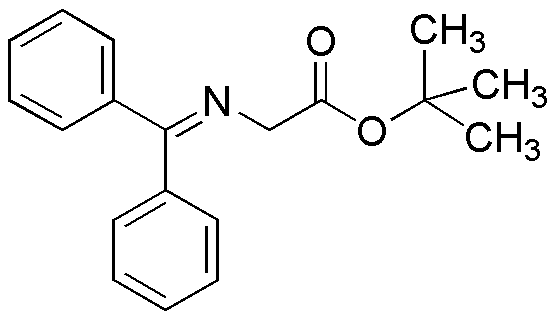N-(Diphenylmethylene)glycine tert-butyl ester is widely utilized in research focused on
- Pharmaceutical Development: This compound serves as an important intermediate in the synthesis of various pharmaceuticals, particularly those targeting neurological disorders. Its unique structure allows for modifications that can enhance drug efficacy.
- Organic Synthesis: It is frequently used in organic chemistry as a building block for creating complex molecules. Researchers appreciate its stability and reactivity, which facilitate the development of new compounds.
- Biochemical Research: The compound is employed in studies involving enzyme inhibition and protein interactions. Its ability to mimic natural substrates makes it a valuable tool for understanding biochemical pathways.
- Material Science: In the field of polymer chemistry, it can be utilized to develop new materials with specific properties, such as improved thermal stability and mechanical strength, making it suitable for high-performance applications.
- Analytical Chemistry: This compound is also used as a standard in various analytical methods, including chromatography and spectroscopy, helping researchers achieve accurate results in their experiments.
General Information
Properties
Safety and Regulations
Applications
N-(Diphenylmethylene)glycine tert-butyl ester is widely utilized in research focused on
- Pharmaceutical Development: This compound serves as an important intermediate in the synthesis of various pharmaceuticals, particularly those targeting neurological disorders. Its unique structure allows for modifications that can enhance drug efficacy.
- Organic Synthesis: It is frequently used in organic chemistry as a building block for creating complex molecules. Researchers appreciate its stability and reactivity, which facilitate the development of new compounds.
- Biochemical Research: The compound is employed in studies involving enzyme inhibition and protein interactions. Its ability to mimic natural substrates makes it a valuable tool for understanding biochemical pathways.
- Material Science: In the field of polymer chemistry, it can be utilized to develop new materials with specific properties, such as improved thermal stability and mechanical strength, making it suitable for high-performance applications.
- Analytical Chemistry: This compound is also used as a standard in various analytical methods, including chromatography and spectroscopy, helping researchers achieve accurate results in their experiments.
Documents
Safety Data Sheets (SDS)
The SDS provides comprehensive safety information on handling, storage, and disposal of the product.
Product Specification (PS)
The PS provides a comprehensive breakdown of the product’s properties, including chemical composition, physical state, purity, and storage requirements. It also details acceptable quality ranges and the product's intended applications.
Certificates of Analysis (COA)
Search for Certificates of Analysis (COA) by entering the products Lot Number. Lot and Batch Numbers can be found on a product’s label following the words ‘Lot’ or ‘Batch’.
*Catalog Number
*Lot Number
Certificates Of Origin (COO)
This COO confirms the country where the product was manufactured, and also details the materials and components used in it and whether it is derived from natural, synthetic, or other specific sources. This certificate may be required for customs, trade, and regulatory compliance.
*Catalog Number
*Lot Number
Safety Data Sheets (SDS)
The SDS provides comprehensive safety information on handling, storage, and disposal of the product.
DownloadProduct Specification (PS)
The PS provides a comprehensive breakdown of the product’s properties, including chemical composition, physical state, purity, and storage requirements. It also details acceptable quality ranges and the product's intended applications.
DownloadCertificates of Analysis (COA)
Search for Certificates of Analysis (COA) by entering the products Lot Number. Lot and Batch Numbers can be found on a product’s label following the words ‘Lot’ or ‘Batch’.
*Catalog Number
*Lot Number
Certificates Of Origin (COO)
This COO confirms the country where the product was manufactured, and also details the materials and components used in it and whether it is derived from natural, synthetic, or other specific sources. This certificate may be required for customs, trade, and regulatory compliance.


